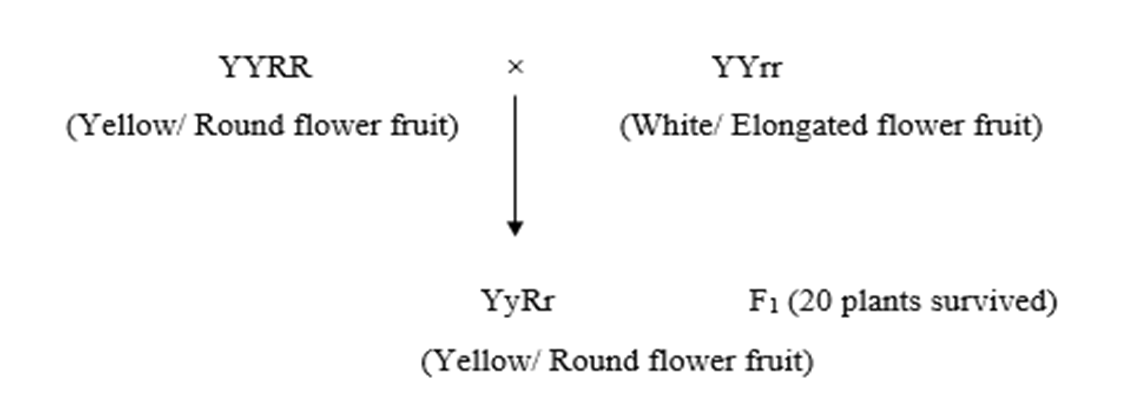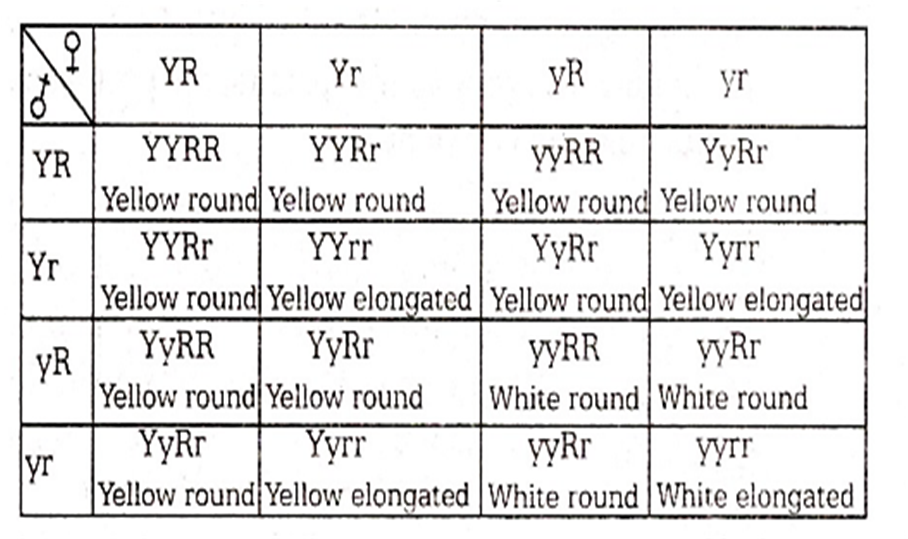 Multiple Choice Questions
Multiple Choice QuestionsIn a plant species, flower colour yellow is dominant over white and fruit shape round is dominant over elongated. Crossing was performed between two pure lines - one having yellow-flower and round-fruit and another with white-flower and elongated-fruit. About 20 plants survived in F1 progeny. Plants of F1 were allowed to self-fertilise and about 960 plants survived in F2. If the traits follow Mendelian inheritance, the number of plants would have yellow-flower and round-fruit in F1 and F2 are respectively
20, 960
20, 540
10, 180
10, 60
B.
20, 540


Ratio of the species is as followes:-
Yellow Rounded : Yellow Elongated : White Rounded : White Elongated
4 : 3 : 3 : 1
Now, out of total 960 species survived in F2 generation. The number of plants that would have yellow flower and round fruit in F2 generation will be
(Total survived) = 540 plants.
Thus, in F1 and F2 -generation, total yellow colour, round fruit plants survived will be are 20, 540.
Which of the following statements is wrong?
Test tube baby grows inside test tube
Test tube baby grows within mother's womb
Test tube baby grows within surrogate mother's womb
Test tube baby grows following uterine fertilisation
The correct sequence of embryonic development is
Blastula - Morula - Zygote - Gastrula - Embryo
Zygote - Blastula - Morula - Gastrula - Embryo
Zygote - Morula - Blastula - Gastrula - Embryo
Gastrula - Morula - Zygote - Blastula - Embryo
The time interval of appearance of fever in the malarial patients depends on the types of malaria. The research evidences suggest that such time intervals are-(1) 36-48 hours, (2) 48 hours and (3) 72 hours. If any such patient experiences fever at an interval of 48 hours, then the said patient suffers from
only benign tertian malaria
quarantan malaria or mild tertian malaria
malignant tertian malaria or benign tertian malaria
mild tertian malaria or benign tertian malaria
The structure of E. coli chromosomal DNA is
double- stranded, right handed and circular
single- stranded, right handed and circular
double- stranded, left handed and linea
double- stranded, left handed and circular
If spermatogenesis proceeds too rapidly, inhibin is released. Inhibin reduces the secretion of
Luteinising Hormone (LH)
Follicle Stimulating Hormone (FSH)
Testosterone
Interstitial Cell Stimulating Hormone (ICSH)
Genetically improved crop varieties can be developed in laboratory by
somatic hybridisation
transgenic technology
cell suspension culture
somaclonal variation
Sand flies play significant role in spreading kala-azar because they
suck blood only from the patients suffering from kala-azar
convert amastigote into promastigote
engulf amastigote at the time of blood sucking from the infected persons
inject promastigote into the body of non-infected persons at the time of blood sucking
Which of the following statement(s) are true?
Antibiotics can kill bacteria, but disinfectants do not
Disinfectants have better bactericidal efficiency than antibiotics
Antibiotics are of microbial origin, but disinfectants are chemical compounds
Antibiotics can be injected into the patients, whereas disinfectants are not
